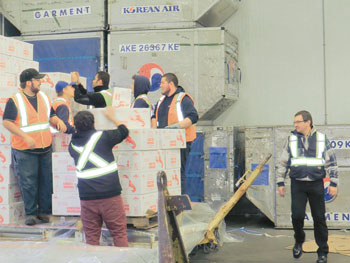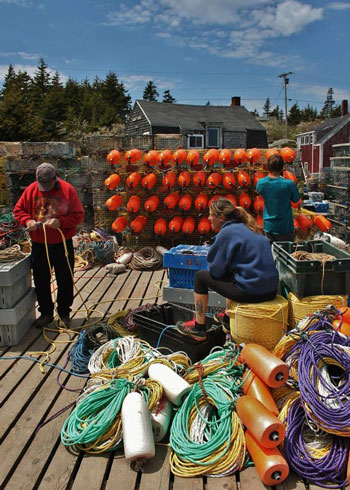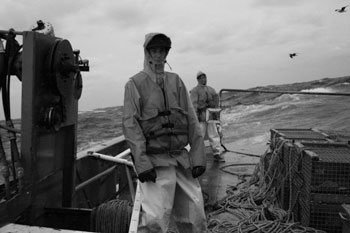Maine Lobster Industry
Continued from Homepage

Once you take the lobster into your facility and put it into a box to ship around the world, the clock starts ticking. It needs to be alive so it can be sold safely by vendors to their customers. – Annie Tselikis, MLDA Richard Stern photo
spending by industry workers. The research involved confidential surveys of dealers and processors as well as analysis of existing DMR and Department of Labor data.
Dealers move lobsters from Maine to numerous markets around the world, and also add value to the product, said Tselikis. In 2016, there were about 300 dealers in Maine.
“When you’re landing thousands of pounds of lobster in the peak of the season, you’ll not only grade and sell it to customers,” explained Tselikis. “Once you take the lobster into your facility and put it into a box to ship around the world, the clock starts ticking. It needs to be alive” so it can be sold safely by vendors to their customers.
The general public doesn’t know what dealers and processors do, and are often not aware of their existence, she said.
“These businesses are hidden in warehouses or at the end of peninsulas,” she said. “People have probably never been in a facility that holds hundreds of thousands of pounds of lobsters, and they don’t understand how incredible that investment is….It’s not just the fishermen on the water. It’s the guys at the dock, the processor picking lobster meat. It’s the people packing lobsters around the clock. These facilities often never close.” Also, she said, “It’s not just the lobster businesses themselves, but the ancillary businesses that support their ability to move the product around the world—truck drivers, packaging companies, water companies, fuel, food,” and more.
Michael Donihue, a Colby College professor of economics who ran the study, said the supply chain is mainly invisible to customers, yet it’s a complicated process.
The industry has shown
it can prosecute “a good
clean fishery and
a good industry.
– Jeff Pierce
Each dealer and processor, he noted, separately impacts its local community, with its spending multiplying throughout the community. Paying wages is a second multiplicative impact.
“The harvesters get a lot of attention” because they’re visible,” said Donihue. “But you don’t realize there’s this whole supply chain that’s the backbone.”
According to a summary at colby.edu/lobsters2dollars, Donihue worked with 21 dealers to develop a survey worksheet of financial and employment data that detailed their operations. In 2017, he led a research team of students and partners, traveling from Kittery to Beals to interview dealers, processors, and co-op managers.
The modeling approach of the project began with a tally of spending by the dealers, on aspects such as maintenance and repairs, utilities, fuel, and supplies, as well as wages paid to employees.
“Each type of spending has its own ‘multiplier’ – a factor that captures the fact that a dollar spent on wages is multiplied in terms of its economic impact as each worker spends their earnings on things like groceries, gas, utilities, and entertainment, which in turn impacts the revenue stream of the grocer, gas station owner, utility company, and entertainment venue,” the summary says.
Similarly, spending on new equipment, maintenance, supplies, and even crate purchases has an indirect effect on the economy in the form of business-to-business purchases.

Right: The lack of vertical integration and owner-operator fishing rules creates two distinct sectors in this industry: harvesting lobsters; and the wholesale distribution and processing of the animal. – LTD Project Findings Joel Woods photo
“Scaling the results of this sample of dealers up to an estimate of the impact for the entire network of dealers in Maine proved to be challenging due to the limited participation of the dealers and restrictions on the availability of employer records from the Maine Department of Labor,” the summary says. “Of the 305 entities holding dealer’s licenses, roughly 100 represent supermarket or grocery stores, restaurants, or other retail outlets. Informal follow-up conversations with a subset of dealers made it possible to divide up the remaining 200 wholesale lobster dealers into size categories representing differences in the scale and scope of operations at various points in the distribution supply chain. Wharves and buying stations made up one group, co-ops another, processors were separated into a third group, and the remaining wholesale distributors were separated by their approximate scale of operation (small, medium and large).”
All told, the summary says, the wholesale lobster distribution supply chain contributes an estimated $1 billion to the Maine economy and supports up to 4,000 workers annually.
Participating dealers were also invited to identify the biggest challenges they face. The list led with profit margins and labor shortages, followed by product quality, then burdensome government regulations and competition from other countries due to recent trade agreements.
“The findings of the Lobsters to Dollars project are important for a variety of reasons, the summary continues. “The lack of vertical integration and owner-operator fishing rules creates two distinct sectors in this industry: harvesting lobsters; and the wholesale distribution and processing of the animal. Yet the wholesale distribution of lobsters is neither well understood nor recognized by consumers and policy makers. At the same time, the entire industry faces threats from competing trade agreements, climate change, labor shortages, and insufficient infrastructure investment.”
We need to know
more about what
our industry brings to
the table for our state.
– Brendan Ready,
Ready Seafood, Portland
The summary continues, “Telling the dealers’ story, and making visible their economic contributions, provides support for the maintenance and repair of Maine’s transportation network and policy initiatives designed to improve the efficiency and sustainability of the lobster industry.”
The work of the dealers and processors is complicated by the need to find markets for their product, said Tselikis.
“We’ve seen an incredible rise in the supply,” she said. “Fishermen have done very well in the last several years. As that supply increase has happened, we’ve had to go out and find markets.”
Getting data from people “who are good friends and fierce competitors” was a challenge, said Donihue.
“It’s the first time we got a good sense of the power of the industry on the Maine economy,” added Tselikis.
Brendan Ready, who owns Ready Seafood in Portland and Maine Seafood Ventures in Scarborough, supported the study. Growing up as a lobster fisherman, he said, he always wanted to know exactly where his catch went.
“It’s going to give harvesters more power and a better understanding of exactly how much your lobsters are worth and how to make more money,” Ready said. “We need to know more about what our industry brings to the table for our state.”

Roger P. Raymond, left and Agniezka Pollak lobster fishing offshore. Offshore lobster fishing in federal waters has increased in recent decades. The boats are bigger, trips longer, demands on gear and crew greater and the catches larger. Joel Woods photo
He added, “When I look at a billion dollars, that’s a shocking amount of money. That’s our industry. That’s our state we’re talking about.”
Scout Wuerthner, general manager of Inland Seafood Company, said it’s important for fishermen and the general public to understand the costs that dealers and processors pay.
Headquartered in South Portland with locations elsewhere in Maine and the Southeast, Inland Seafood handles all facets of lobster industry.
“People have to understand what dealers go through” when it comes to paying for equipment, trucks, marketing, and the like, as well as lost revenue due to shrinkage. “Everything we can do as an industry to control our shrink is very important,” Wuerthner said. “And it’s a sin that this stuff doesn’t get to somebody’s plate. It’s horrible that we’re taking it out of the ocean and no one gets to enjoy it.”
“There’s huge opportunity for better collaboration,” said Tselikis. “There has to be better cooperation within the entire industry, because the industry is changing, the resource is changing, the quality of the product is changing, the market is a lot more diverse, and we’re asking a lot more of lobsters that we’re shipping great distances these days.”
Tselikis said it’s the study organizers’ hope to continue to plug in data in coming years.
“That will give us a great picture of the true value of this fishery,” she said.
